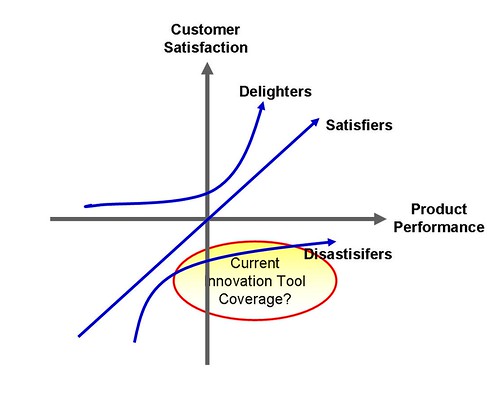Innovation Coverage of All Customer Needs
 John Caddell posted this week about an alternative approach to product innovation. He discusses an HBR article written by Professor Robert Verganti about the Lombardy design cluster utilized for design innovation that uses a small community of diverse professionals...
John Caddell posted this week about an alternative approach to product innovation. He discusses an HBR article written by Professor Robert Verganti about the Lombardy design cluster utilized for design innovation that uses a small community of diverse professionals...
'a free-floating community of architects, suppliers, photographers, critics, curators, publishers, and craftsmen, among many other categories of professionals, as well as the expected artists and designers. The members of the community are prized as much for their immersion in a discourse as for their originality.'
John starts off by asking 'tired of hearing about open innovation'. This comes from a a growing movement today towards talking to your employees, customers, and suppliers for better innovation. I am a proponent of talking to your customers, I believe in the wisdom of crowds, but I can see that there are areas of innovation where customers can't always be the source for all innovation.
This got me thinking about Innovation coverage. To be a truly effective innovator, I think a company needs to have a suite of innovation options depending on the needs. Think about the Kano Model used in Process Engineering. It talks about 3 different types of requirements that are produced.
- Disatisfiers: aspects of a product/service that will cause dissatisfaction if not present. (eg. - brakes on a car)
- Satisfiers: aspects of a product where more is better. (gas mileage - the better gas mileage your car gets, the happier you are)
- Delighters: these are aspects of a product that the customer didn't expect, but when they are their, the customer is delighted. This is often the purple cows that Seth Godin talks about. (eg. - A sunroof in a car... when it first came out at least, or a chocolate on your pillow at the hotel)
However, in reality, innovation can and should happen in all three levels of the Kano Model. Unfortunately today most companies don't utilize all tools at their disposal. Just like building a house, a hammer won't work for all tasks. Today many companies take the hammer approach to innovation. Most often the hammer is an internal R&D department. What companies need to do is develop an innovation tool belt where they can tap your customers, expert communities, internal and external R&D experts well as the wisdom of crowds based on the need. The second step is knowing when to best utilize the different tools during the innovation life cycle and for what tasks, and what products or services they should be used for to give you the highest innovation efficiency. Having a full set of tools along with the knowledge of when and how to use them, will set a company up better to approach their innovation imperative.
No comments:
Post a Comment